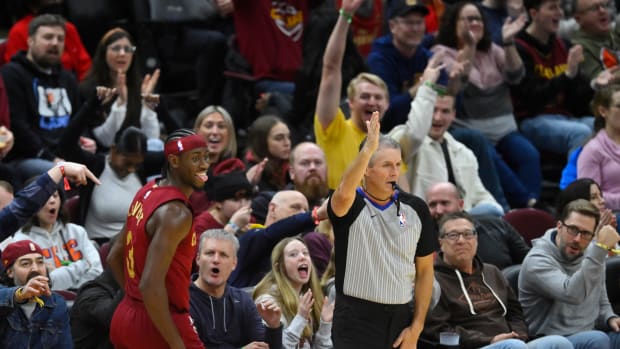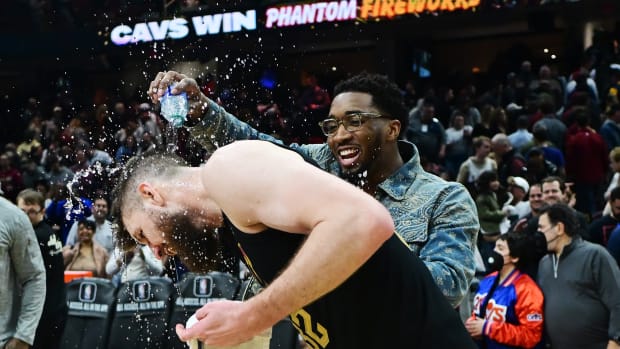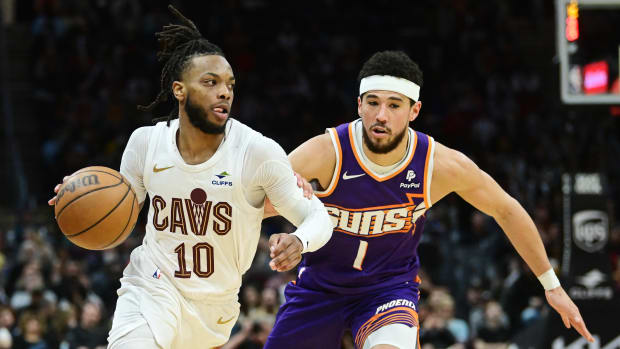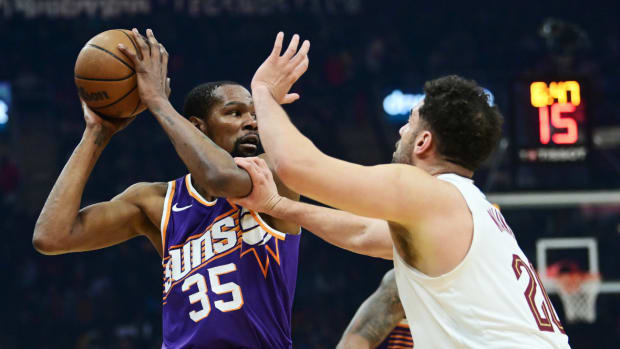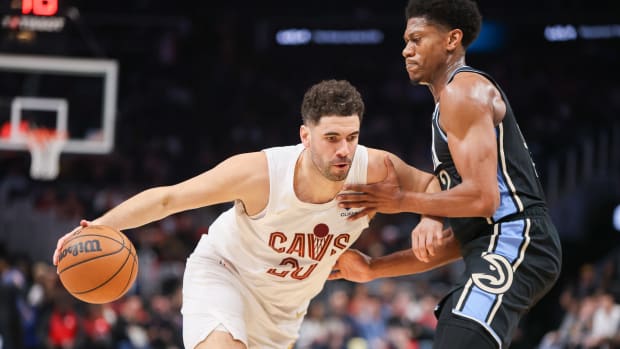Celtics legend Cowens talks of hustle, small-ball as a center and winning big

He's a two-time NBA champion, NBA Most Valuable Player, All-Star Game Most Valuable Player, eight-time All-Star and a member of four halls of fame, including both the College Basketball Hall of Fame and the Naismith Memorial Basketball Hall of Fame.
So, he's a big deal, right?
"Uh, no!" Dave Cowens says, his voice cracking into a voracious laugh. "I played basketball, and I loved playing and competing, but I think there's an overinflated opinion not just by basketball players, but by athletes, as a whole, that people care about what they think.
"I was never that way."
Now 71, Cowens, a Newport, Ky. native, has lived by the credo.
"To me," he said during his speech while being inducted into the Naismith Memorial Basketball Hall of Fame in 1991, "the bigger the reputation, the smaller the ego, the better the person."
LITTLE BIG MAN
Imagine, for a moment, LeBron James playing center, doing so against guys such as Wilt Chamberlain, Kareem Abdul-Jabbar, Willis Reed, Wes Unseld, Bob Lanier, Artis Gilmore and Moses Malone.
Now, imagine LeBron doing so 20 pounds lighter than his listed playing weight of 250.
That's what Cowens, who played at 6-foot-9, 230 pounds, did during his storied 11-year NBA career.
What Cowens did on the court while playing in the NBA was and remains impressive, considering whom he was going against night in, night out, it's remarkable.
Cowens averaged a double-double of 17.6 points and 13.6 rebounds, along with 3.8 assists and 1.1 steals in 766 career NBA games. He was named to the All-NBA second team three times, was named to the All-NBA Defensive first team in 1976 and All-NBA Defensive second team in 1973 and 1980. Cowens was a member of the Celtics' 1974 and 1976 NBA championship teams.
Imagine, though, how his pedal-to-the-medal, balls-to-the-wall style would translate to today's game, with the emphasis on small-ball lineups and getting up and down the floor.
Cowens was most certainly ahead of his time.
"Boy, am I glad someone finally noticed and said that!" Hall of Famer Tommy Heinsohn, Cowens' coach for seven-plus seasons during his playing days with the Celtics, told Sports Illustrated with a big laugh.
"Dave was so far ahead of his time, especially compared to the guys he played against and to those who came before him.
"The Big Man Era, which started with George Mikan, then Wilt Chamberlain came in, with Bill [Russell] defending him, was the way the game was played then," the Hall of Famer who remains with the Celtics as a member of their television broadcast team continued. "It continued with Kareem Abdul-Jabbar and on and on.
"Dave Cowens was an exception... the exception. He was way, way ahead of his time and would fit perfect in today's game."
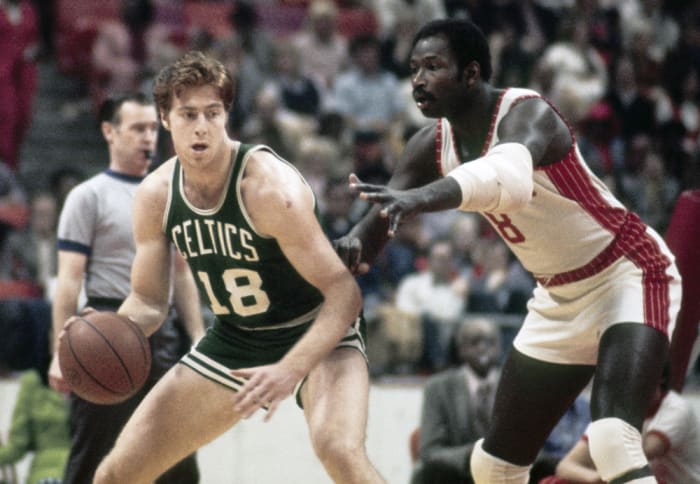
Dave Cowens' relentless approach helped lift the Celtics to two titles during his time with the team.
USA TODAY Sports file photo
CENTER OF ATTENTION
Cowens elaborated just how vital the big man was in the 1970s for the Celtics (and really, dating back to the Bill Russell era, if not earlier).
"So, you know, in Red [Auerbach]'s plays, there's six plays," Cowens explained. "The one, the center handled the ball. The two, the center-center pick. The three, the center handled the ball.
"Also, the four, the six -- I don't know if the five did -- and then in our spread offenses, the center was out there all the time."
"Dave was quick, fast, strong and skilled and played hard," Knicks Hall of Fame center Willis Reed said of Cowens.
It meant guys who played in the pivot had to have plenty in their toolbox.
"That's how centers were used differently than today, there was more of a skillset, because we all had hook shots, they all had little jumpers, you know, they had a backup game and stuff like that," Cowens said.
EYE-OPENING EXPERIENCE
Heinsohn admitted he had never laid eyes on Cowens until the summer before his rookie season of 1970-71.
"I had never seen him until we got up to the summer play in the Catskills and like John (Havlicek) at Ohio State, he was known as a defensive player at Florida State," Heinsohn said. "Really, we felt he would have been more of a power forward, but the way it worked out, he ended up being our center.
"Red (Auerbach) said he could see Dave as playing at the front of our defense and handling the ball, passing and shooting in our offense. Obviously, Red was right.
"We made him a point center in that he would be a ballhandler, passer and perimeter shooter, still with the ability to go down on the block and post up. He was a great trailer on our fast break."
Playing quick was a trademark of the legendary Celtics teams and turns out, of Cowens, too.
"When I played in high school [he only played as a junior and senior], we averaged -- in 32 minutes -- more than 90 points game," Cowens said. "My senior year at Florida State, we averaged 92 points and held our opponents to 78. I was very fortunate to play for two coaches who wanted to play fast, Jim Connor in high school and Hugh Durham at Florida State. We were always pressing on defense and running on offense.
"So when I got to the pros and the Celtics, that was their style of play, so it was a perfect fit for me."
Not that it was smooth sailing to get to that point, though.
"It wasn't easy for me to convince Dave he could shoot the basketball from 18 feet," Heinsohn said through another laugh.
"If you've got pretty good depth perception, you should be able to develop a pretty good jump shot or shot, in general," Cowens said. "It comes down to being willing to put in the work necessary to reach that point.
"I never had a problem putting in the work."
Aurebach agreed, offering this assessment of his red-headed rookie big man in 1971.
"He's a very dedicated kid. A dedicated kid isn't unheard of, but there aren't as many around as we would like," he said. "But our problem with Cowens is telling him when to lay off. He does too much."
Hall-of-Famer Havlicek was point blank on his assessment of Cowens.
"No one ever did more for the Celtics than Dave Cowens," the late Havlicek said.
BIG SHOES TO FILL
Cowens was the Celtics' first legitimate player in the pivot since the legendary Bill Russell retired after leading the Boston to the NBA title in his final season in 1969, doing so as a player-coach.
Surprisingly, Cowens said he felt no additional pressure in trying to live up to Russell's almost-mythical standards, most especially winning a league-record 11 NBA championship rings in 13 seasons.
"I didn't really think about it much. I got that question a lot, especially in the beginning," Cowens said. "But I thought, 'It's silly for me to even think about that!'
"All I was trying to do was, and it started for me in college, was trying to set my own standards that I could strive for. I couldn't control anyone else's, so why should I even think about it?"
Boston selected Cowens with the fourth overall pick in the 1970 NBA Draft out of Florida State University.
"Red [Aurebach] had sent Mal Graham, who was an old point guard from New York, to come see me play," Cowens explained. "He recommended to Red that he come see me play, which he did when we played in Dayton."
Where was Cowens and what was he doing when he found out he was drafted? Remember, 1970 was pretty much The Stone Age when it came to communications.
"I was on my way to the PE building (at Florida State) and passed by someone who told me, 'You were drafted by the Celtics,'" he said. "I then went into (coach) Hugh Durham's office and we talked about it a bit, but that was pretty much it."
Cowens is proud of being part of the NBA Draft Class of 1970.
"[Hall of Famer NBA writer] Bob Ryan told me our class coming out has more guys in the Hall of Fame than any, eight," Cowens said. "Pete Maravich, Bob Lanier, Rudy Tomjanovich, Charlie Scott, Dan Issel, Calvin Murphy, Tiny Archibald and myself.
"So I'm in some pretty darn good company, for sure."
In 1973, Cowens averaged 20.5 points, 16.2 boards and 4.1 dimes while helping the Celtics to a league-best 68-14 record. In a game that season, Cowens scored 20 points, grabbed a career-high 32 rebounds and dished out nine assists in a home win over the Houston Rockets.
He led the Celtics to the Eastern Conference Finals, where they met the Knicks. Boston won Game 1 of that best-of-seven series after Cowens recorded 15 points and 18 rebounds. However, they dropped Game 7 of that series.
Cowens earned NBA MVP honors as well as being the MVP of the All-Star Game. However, there's this:
That season, Cowens joined Celtics legend Russell with the distinction of being named MVP of the league, but not deemed worthy enough of earning first-team All-NBA recognition.
A TRAIL BLAZER
Speaking of the "good company," Cowens referenced, there's this:
In the history of the NBA, five players have led their respective teams in all five major statistical categories for a single season, four of whom are considered some of the most versatile players in the last quarter-century.
Scottie Pippen, Kevin Garnett, James and Giannis Antetokounmpo share the distinction of leading their teams in points, rebounds, assists, blocked shots and steals.
None of them, however, spent their entire career, or 99.9 percent, at least, playing center.
The first player to accomplish that feat did, however, doing so more than four decades ago.
You guessed it, Cowens, who averaged 18.6 points, 14.0 rebounds, 4.6 assists, 0.9 blocks and 1.3 steals for the Celtics in the 1977-78 season.
"Well, they finally caught up to me," Cowens said, once again, laughing. "Really, though, I probably led my team in a couple more -- personal fouls and turnovers -- but no one wants to talk about that!"
Actually, Cowens did not begin his NBA career at center. When the Celtics hosted the Knicks in their opener at Boston Garden in his rookie season, he did so at power forward, meaning he didn't have to match up with Reed in his first game.
"I actually started off playing power forward, meaning I was matched up with Dave DeBusschere," he said. "Garfield Smith began the season at center. After a couple games, I was moved to center and that's where I stayed."
That first season, Cowens averaged 17.0 points, 15.8 rebounds and 2.8 assists in 38.0 minutes in 81 games, shooting 42.2 percent from the field and 73.2 percent from the free-throw line.
However, despite his terrific statistical line in his first NBA season, Cowens was disappointed.
"My rookie year, we didn't make the playoffs, even though we had a better record than two teams that did [Baltimore and Atlanta]," he said. "In those days, though, they took the two top teams from each division in both conferences, and we finished third in the Eastern Division."
Boston won 44 games, behind the 52-win Knicks and the 47-win 76ers in the Eastern Division. Meanwhile, Baltimore and Atlanta, which finished one-two in the Central Division, won 42 and 36 games, respectively.
"I wanted to keep playing. I wanted to play against the best."
THE BIGGEST OF CHALLENGES
Cowens admitted playing against Chamberlain was, literally, a game-changing experience for him.
"Wow, Wilt was something else," he said. "In fact, he was the main reason I brought the jump hook back to the NBA. I got tired of him and guys like Wilt, Jabbar and Nate Thurmond knocking my shots down.
"I remember asking Satch [Celtics teammate Tom Sanders] if he had ever seen anyone else shoot a jump hook in the NBA and he said there used to be only one guy, back in the day, and he drove Russell absolutely crazy because he couldn't get to the guy's shot.
"So I worked on it, and worked on it and it. I wanted to get a quick shot I could use against them because if I took that step and a half and tried to shoot, I couldn't get it off against Wilt and those guys because those guys were so long, they'd just knock it down. It was a different shot and I was able to get it off because it was a quick shot and they couldn't get their arms up to get it."
Another part of Cowens' strategy of matching up with Chamberlain was to stay away from the paint.
"I'd go outside and Wilt wanted no part of going out there and guarding me," he said with a laugh. "I remember one time we were playing the Lakers and since Wilt didn't want to come out that far, I was getting wide-open shot after wide-open shot. But I couldn't make anything. I mean, I was missing everything... just clanking them off the rim left and right.
"During a timeout, I go to Tommy and say, 'I don't want to shoot anymore.' Then I said to Hondo [Havlicek], 'Don't pass me the damn ball. I can't make even one damn shot!' Hondo looked at me and said, 'That's not going to happen. That's not the way it works. We're going to keep passing you the ball, so shoot it.'
"That was a real turning point for me, hearing that from a guy like John. Tommy also always encouraged me to shoot and I developed a decent 15- to 18-foot shot."
Hall-of-Fame coach Bill Fitch, who coached Cowens in his final season with Boston in 1979-80, when the Celtics finished with a league-best 61-21 record, had high praise for Cowens.
"Cowens got as much out of a small body than any center I'ver ever seen," Fitch said.
STILL AT WORK
Cowens remains attached to the NBA game, working as a board member of the The National Basketball Retired Players Association (NBRPA), non-profit association composed of former professional basketball players of the NBA, ABA, Harlem Globetrotters and WNBA. Cowens helped found the organization.
"We're doing a lot of good. We want to do as much as we can for our players. We have a fund if a guy needs money for something that comes up, like a mortgage payment, etc., we can help," Cowens said. "The health insurance the NBA and the Players' Association paid for for all retired players... that is just huge. It's so important because of our 1,000 members, most are age 55, or older. Since we're all old, it was really, really difficult for us to get a good [insurance] rate, so when the league and the players stepped up to pay for the health insurance, it changed everything.
"We provide scholarships in Dave DeBusschere's name, more than $200,000 a year. We also have the Earl Lloyd scholarship fund. We take a lot of pride in these types of things. We've also incorporated the WNBA and the Globetrotters. Those groups don't make nearly the money guys who played or play in the NBA do, so it's great we can help prepare them for what's coming after they are done playing."
Ironically, modern technology is playing a huge benefit to the league's former players -- video games.
"Thanks to the Collective Bargaining Agreement, if a retired player's name or likeness are used in a video game, the players are paid for it," Cowens said. "It's huge for our members as a group, to the tune of like $2 million a year."
Cowens realizes it may become more difficult to convince the players of today. The average salary for an NBA player today is $7.7 million. When Cowens entered the NBA in 1970, the average salary was $35,000.
"With so much money going to today's players, the [retired players association] is searching for ways for us to still be there for today's guys," he said. "We really want to extend the brotherhood. It's a fraternity -- all of us, we've lived a lifestyle not many have the opportunity we do."
AT THE HELM
Cowens caught the coaching bug, actually following the lead of Russell by being player-coach of the Celtics, doing so for the last 68 games of the 1978-79 season, posting a record of 27-41. He returned to player-only duty the following season.
Here's the rundown of Cowens' coaching journey after dipping his toes into the water in 1979 [Cowens' first endeavors after retiring as a player were being athletic director at Regis College, a liberal arts college for women in the Boston area. He then went on to become the Chairman/Executive Director of the New England Sports Museum before helping found the NBRPA]:
* He coached the Bay State Bombardiers of the Continental Basketball Association in the 1984-85 season.
* Cowens returned to NBA coaching ranks, serving as an assistant coach for the San Antonio Spurs in 1994 through 1996, first for John Lucas then for Gregg Popovich. [Cowens was considered for the Celtics' coaching job during the 1995 offseason.]
* He was head coach of the Charlotte Hornets from 1996 to 1999, leading them to the playoffs in the first two seasons and compiling a 109-70 record (.609).
* Cowens was an assistant with the Golden State Warriors in 2000, then served as head coach for the 2001 season and 23 games in 2002.
* He was head coach of the Chicago Sky of the WNBA for the 2005-06 season.
* Cowens finished his coaching duties as an assistant coach for the Detroit Pistons in 2008 for Flip Saunders and 2009 for Michael Curry.
QUICK HITTERS
* On marketing of individual players and not teams:
"Really, it's been going on forever," Cowens said. "Think about it -- in the 1940s, it was, 'George Mikan and the Minneapolis Lakers.' There were hints of it, even back then. So I can't say I disagree with marketing a person over a team. But the way you play, that has nothing to do with marketing -- that's a business decision."
* On spending some time playing in the Catskills in the summer before his rookie season with the Celtics:
"That worked out really well. Wilt played there, but he was also a bellhop one summer because he needed a second job. How incredible is that? Nowadays, there isn't much a need for a guy to have a second job."
* On the Celtics adding Paul Silas before the 1973 season, acquiring him from the Phoenix Suns for Hall-of-Fame guard Charlie Scott (Boston would require Scott less than three years later, sending Paul Westphal and two second-round picks to Phoenix in exchange):
"Paul Silas coming in, that was huge because now we had a monster. We formed kind of a rebounding tandem, similar to what Elvin Hayes and Wes Unseld were with the Bullets. Bringing in Paul really allowed me to go outside because Paul was always down on the block. On defense, we could also always switch any time we needed or wanted to. We both liked playing defense and rebounding."
* On former legendary Indiana University coach Bob Knight, a collegiate teammate of Havlicek during their days at Ohio State:
"I always get a kick out of him being called this 'defensive guru,' because he was such a gunner during his days at Ohio State," Cowens said through another of his trademark laughs. "The fact is, his teams at Indiana were always said to play good defense, but that was because they always held the ball and hardly shot!"
THE PLAY
No discussion about nor with Cowens himself can be complete without talking about The Play.
If you haven't seen it, imagine the greatest hustle play you've ever seen on an NBA floor. Now, imagine it being done on one of the worst playing surfaces of the history of the league and it being done by a center attempting to play defense against one of the greatest point guards to ever lace 'em up.
Without further ado, here's Cowens, having started the play guarding the NBA's all-time leading scorer, Kareem Abdul-Jabbar of the Milwaukee Bucks, being switched onto Hall-of-Fame point guard Oscar Robertson, first defended by Celtics guard Don Chaney before the switch during the closing moments of Game 6 of the 1974 Finals
As per his usual, Cowens was his normal, self-deprecating self when asked about The Play.
"Well, that seems to be one a lot of people recall," he said, laughing. "And really, I was just very good at being able to fall down."
When pressed, Cowens, albeit reluctantly, described what took place.
"Really, though, at that point, Oscar was a bit of an older guy, so I was able to move my feet and he kind of put the ball out there so I just poked it and took off," he explained. "I couldn't see if anyone was near me and I couldn't get my feet under me, so I just went after it and was lucky enough to come up with it and the jump ball. I think I kind of caught Oscar off-guard a bit."
There was also the issue of diving head-first onto the parquet at The Garden, known for its uneven squares of hardwood, its nuts and bolts and, of course, its splinters.
"I used to go around and look at the court at the Garden, and in every arena, in fact, to see where the bolts were, where the floor was uneven, to see where I could land if I hit the deck," Cowens revealed, "Of course at The Garden, it wasn't sliding, it was skidding.
"Those weren't splinters, they were [skin] slices!"
In truth, The Play wasn't anything unusual for Cowens, who was known for his fiery, aggressive style. It just happened to occur on the game's biggest stage while being matched against a fellow member of the NBA's 50 Greatest Players [as selected by the league in 1997].
"I never thought of myself as a superstar. I represent the working class of the NBA," Cowens said during his induction speech while being inducted into the Naismith Memorial Basketball Hall of Fame in 1991. "I'm honored they've selected me, because I could name a whole lot of guys who were better than Dave Cowens.
"You have to play with the right people and get picked by the right team. Let's face it, I was pretty lucky."
FAMILY TIES
Cowens comes by his giving/competitive sides honestly.
He was one of six children of Jack and Ruth, him being the second-oldest. He credits his older brother, Wayne, for his competitive nature.
"Seeing what my brother was accomplishing and how competitive he was, not in athletics but in academics and then in business, it was something I really admired," Cowens said. "He really pushed me to give it everything I had."
That having been said, Cowens has never forgotten the importance of giving.
"Giving, that's very important. I learned that at an early age, from my parents, Ruth and Jack, that an integral part of attaining happiness and success is in giving," he said. "Giving of your thought, giving of your spirit."
In terms of his on-court legacy, Cowens offers a matter-of-fact assessment.
"Hey, stats don't lie -- they are what you were or are," he said. "But what people will remember for you was your style. I never wanted to give a coach a reason to take me out of a game. I would have been a terrible bench player. I always wanted to be someone who my team needed to have out on the floor.
"I loved the activity, I always played with a style most would call 'reckless abandon.' But I didn't look at it that way -- it's the only way I knew how to play. I always liked playing defense, and I really like playing aggressively, so it seemed only natural for me to play that way."
The way he played seems to carry more weight with the two-time NBA champion.
"I never really looked at it that way," he responded when asked about the importance of winning. "I figured I would go and do the best I can, everything I could do for my team, to my fullest ability. Along the way, I also figured I'd might as well have a good time. It was a lot of fun to be able to play the game.
"In the end, how much did you contribute to the activity? The game? Did you do your job? That's how I always looked at it. I firmly believe, the greatest players are the ones who give the most."
SETTLING IN
Cowens and his wife, Deby, married in 1978 and have two daughters and three grandchildren.
"We spend nine months a year here in Maine, and January, February and March in Fort Lauderdale," he said.
"Life is good. My daughters and their families live in the same neighborhood as us. We can walk to each others' homes. My wife and I, we have been very blessed."
Though all the fame, fortune, acclaim and blessings, Cowens still adheres to the belief he's anything but a big deal.
"I've been married since '78, so I've gotten more than used to hearing that!" he said through one, final huge laugh. "I'm nothing special... I played basketball, but man, this life sure is."

